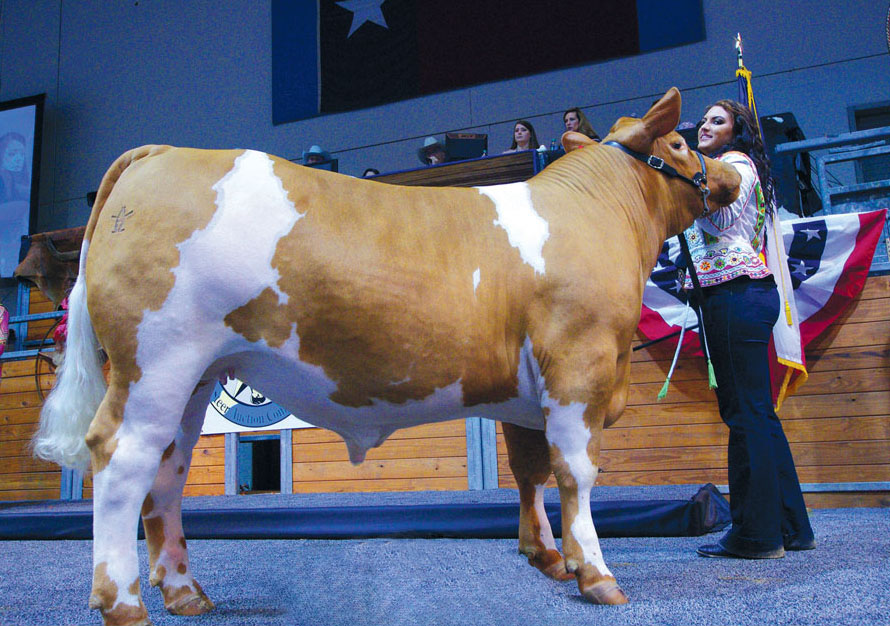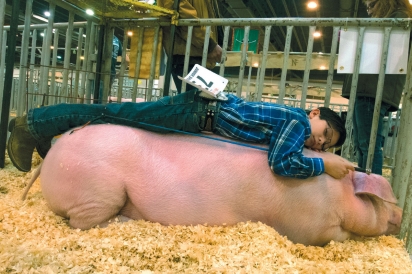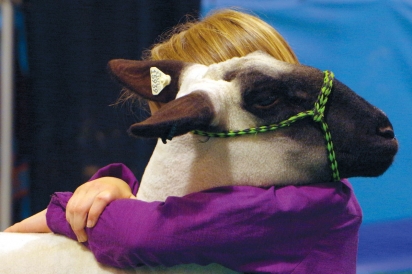Trail to the show
No wonder the Houston Livestock Show & Rodeo ranks among the top scholarship programs in the nation: Since its inception in 1932, the Livestock Show has contributed a staggering $400 million to educational commitments— funds that have changed the lives of Texas’ youth dramatically. This year, it pours another $25,858,260 into the coffers, to be split among educational program grants, graduate assistantships, college scholarships and Junior Market Show award-winners.
PLAYING FOR HIGH STEAKS
A year ago, Caitlen Hope Doskocil matter-of-factly led her orange-and-white steer, Peaches, from the family trailer to his pen in the cavernous NRG Center. The routine was pretty familiar, after all: The 17-year-old honor student and Holland FFA member had led a steer into a show barn to compete at the Houston Livestock Show and Rodeo every year since she was 8. After almost a decade without a win, she would take one final run at the honor of producing the Junior Market Grand Champion Steer before heading to Texas A&M in the fall to pursue a dentistry degree.
Caitlen, as do all the other young competitors, had meticulously tended, fed and nurtured her slick 1,379-pound steer— whose destiny involves a one-way trip to the butcher’s—for two to four hours a day for an entire year, just as she had the ones in all the years before. And Peaches was, in fact, carved from the herd to rank among the top 420 steers selected to go from the auction block to the butcher’s block on Saturday, March 21, 2015.
The eve of the auction found Caitlen in tears—but not for Peaches’ ultimate fate: She had just learned that Peaches was crowned Grand Champion among the top 30 or so contenders. After years of try, try and try again, her unflagging grit and persistence had propelled her to the top and the $75,000 scholarship prize money accompanying the title to help see her through dentistry school.
Grand Champion winners in the Junior Market Show are guaranteed the $75,000 prize money regardless of what their animal brings at the high-rolling charity auction, with any remaining funds from the top bid flowing back into the HLSR educational fund. Peaches fetched $300,000 this past year—a princely sum, but only half of the world record price of $600,001 set by the 2002 Junior Market Grand Champion back when Houston’s oil-based economy was a bit more robust.
While the Grand Champion Steer undoubtedly attracts the most attention, the Junior Market hosts many more agricultural categories including dairy cattle, swine, sheep, lambs and poultry—plus an all-new “Iron Chef”-style “Food Challenge” that debuted in 2015 with 57 teams; as of February 1, more than 90 teams had pre-registered for this year. Judges up the ante by grilling contestants on kitchen hygiene, proper handling and cooking temperatures of specific meats, and nutritional components of the ingredients along with their evaluation of taste and presentation.
THE LIVESTOCK SHOW’S “FARM TEAM”
The tens of thousands of youth participants in the Houston Livestock Show hail from the width and breadth of Texas, and must be state residents attending public schools. In addition, students must be Future Farmers of America members or in a 4-H program; some youth belong to both. Their missions align: FFA’s mission is agricultural education to prepare students for successful careers and a lifetime of informed choices in the global agriculture, food, fiber and natural resource systems, which will become increasingly challenging as natural resources shrink and populations explode. To expand its reach, the organization has even dropped the moniker “Future Farmers of America” from its name entirely, rebranding itself simply as FFA.
While FFA is for students enrolled in agriculture-related curriculum in Texas public schools, 4-H membership—it’s a youth-development program of the Cooperative Extension system of land-grant universities—is open to any student 9 to 19. Its broader-based mission of “Heads, Hands, Heart and Health” allows it to reach youth in all 254 Texas counties, whether urban, suburban or rural.
And although many imagine FFA to be for rural youth, dramatically shifting demographics make growing the next generation of farmers quite challenging: Consider that 38% of Texas’ population was rural in 1950 and as of 2010 only 15% was, according to U.S. Census data. With analysts forecasting that the world’s population will top 9 billion by 2050, FFA is pedaling as fast as it can to attract, motivate and educate a new generation to innovate sustainable farming techniques in an increasingly urban environment while reinventing itself to address the rural-to-urban population shift.
Cady Tompkins, a 2015 graduate of Baytown’s Sterling High School, participated in FFA her entire high school career as an enhancement to her classes in animal science, equine science and introduction to agricultural science. “The horticulture class was the toughest,” she confides, “as the test involved a 100-plant identification test.” Cady raised lambs all four years of high school and also raised goats her sophomore year. She goes on to say most of her fellow FFA members lived in suburban neighborhoods, as does she, without access to farm or ranch land—which meant driving … a lot.
Sterling—as is the case with many urban and suburban high schools—has limited on-site facilities for agricultural programs, so program leaders must be creative and find area farmers or ranchers who are willing to lease facilities to FFA students for a nominal fee. (In Cady’s case, it was a $100 fee, $50 of which was refunded at the end of the year when the rented facility was vacated in good condition.) That meant driving to the barn before school and after school … not just when she felt like it, but every day.
To the west, Katy’s James E. Taylor High School faces a similar struggle with land availability. “The high school only has room enough for chicken coops and a garden,” says FFA student Forrest Steele, who will enter his Whooping Crane educational display in the Ranching and Wildlife division at this year’s Livestock Show. “The barns and pens are north of I-10, which means students have to drive themselves or have someone else take them to care for their animals twice a day.”
As Houston’s metropolitan growth up the I-45 corridor has changed rural landscapes into suburban subdivisions with covenants that prohibit livestock, even once-bucolic Conroe is now suburbia. Prior to the opening of the Otwell Agricultural Park and Livestock Complex a few years ago, Conroe’s Oak Ridge High School FFA students had to drive up to 80 miles daily to tend their animals. With use of the new facility in full swing, FFA participation at Oak Ridge has nearly tripled, helping the Texas FFA Association become the largest in the nation by the end of the 2013–14 school year with 103,379 members in 1,021 chapters.
SHOWTIME!
The days leading up to the Livestock Show test even the steeliest nerves among would-be contenders, as an animal becoming sick could dash a year of day-in, day-out hard work and preparation, dashing hopes for the prize money. But what these youth learn in FFA is far more than a chance to compete for prize money. “FFA changed my life and impacted me enormously,” Cady says. “I discovered that I’m way more responsible than I ever thought I could be; it’s a huge responsibility to take care of livestock twice a day. Plus, I learned teamwork, parliamentary procedure, public speaking and leadership skills by serving as FFA secretary my sophomore year and as reporter in my junior and senior years.”
Full February frenzy has gripped the NRG Center as HLSR staff, along with more than 32,000 volunteers, prepare for the March 1 opening date. As I walk through the acres of temporary pens, boys and girls fuss over their charges as would a stage mother: primping, petting, polishing. Some will take home trophies, and a share of the $7.5 million prize money. Many of them will dedicate their lives to feeding generations to come. Perhaps best of all, each and every one of them will have had their lives transformed by the year they’ve spent leading up to the Show.







